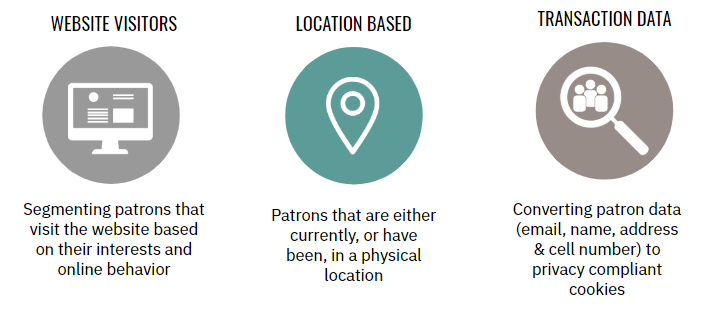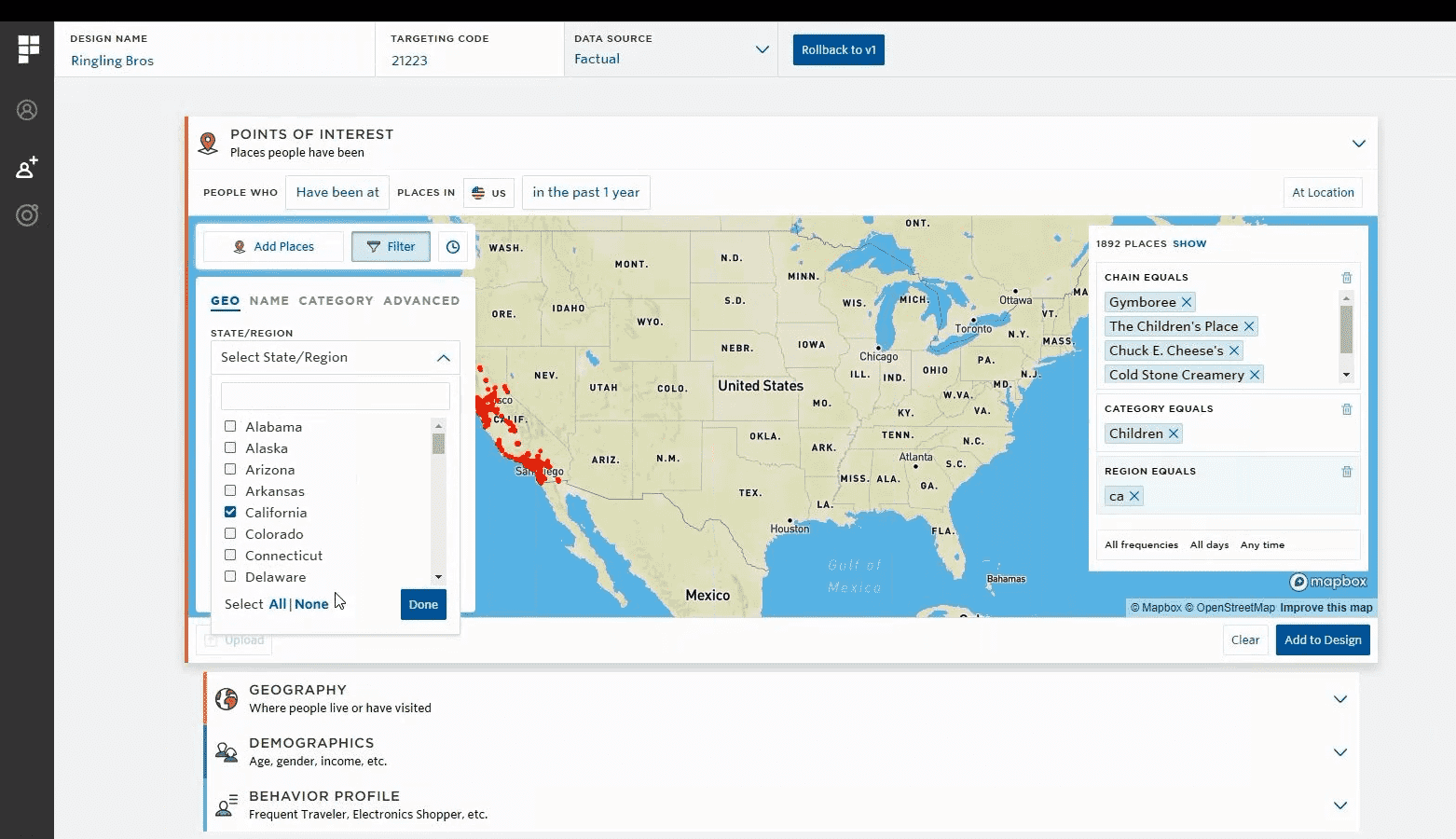In the past, there have been two primary ways to use location to target audiences online: geotargeting and geofencing.
Geotargeting involves targeting a formally-defined area like a DMA, a county, a city, or a zip; it’s how we buy traditional media like TV, Radio, and print. Outdoor is all DMA, market-driven, and fairly broad.
Geofencing, alternatively, involves targeting a user-defined area, using a circle or trapezoid shape over any desired area. With both geotargeting and geofencing, we’re able to target patrons that are currently within a defined area. Now, arts marketers can reach patrons even after they’ve left these locations through an innovative practice called place targeting.
What is Place-Targeting?
Place targeting can target patrons that are currently within a physical location, like an individual Starbucks or an Apple Store, and target these patrons long after they’ve left these locations.
 Place targeting is an incredibly powerful tool for digital marketers because where we go and the places we visit say a lot about our demographics, interests, and behavior. It can also reveal clues of a patron’s mindset. What can we infer about someone who recently visited places like Chase Bank, a concert venue, a Sephora store, a Best Buy, a college campus, or a Honda dealership? We can interpret a great deal about patrons from location-based data, and target these audiences accordingly, once they’ve left these places and continued on with their daily lives.
Place targeting is an incredibly powerful tool for digital marketers because where we go and the places we visit say a lot about our demographics, interests, and behavior. It can also reveal clues of a patron’s mindset. What can we infer about someone who recently visited places like Chase Bank, a concert venue, a Sephora store, a Best Buy, a college campus, or a Honda dealership? We can interpret a great deal about patrons from location-based data, and target these audiences accordingly, once they’ve left these places and continued on with their daily lives.
How it Works
Data is a must-have resource for advanced digital marketing. Just this year, marketers in the US will spend nearly 15 billion dollars on data (MediaPost). We use data to target more precisely, to reduce costs, and to deliver exceptional results for a partner’s precious marketing budget. This data can include demographics like gender, age, home ownership, or in-market behaviors for household appliances, MBA-earners, or theatre ticket purchasers–and, now, based on granular locations via place targeting.
Meet Factual
Factual, the leader in location data, aggregates location-based data for marketers in a highly transparent and privacy compliant manner. They partner with a variety of companies including Uber, Yelp, MasterCard, Whole Foods, Mogo and more, to track consumers through their unique device IDs.
Mobile devices have a device ID (a unique signature) that can be coupled with a user’s location; this is how Uber finds you to pick you up and Yelp gives you restaurant recommendations nearby. And it’s not solely marketers who use location data and device IDs–it’s also used for security to prevent identity theft. For example, your bank may use your device ID and your location to prevent someone from logging in as you from a foreign country and stealing your identity or funds. They may also use it to tailor content to you when you log in or visit their site.
Factual receives mobile sensor data, which includes a device’s latitude and longitude, and the device ID. Then, Factual validates that the device is at a specific location. Once verified, the device ID is added to a database, where Factual partners can access the data. From this data, we can build a custom audience or leverage prebuilt location audiences and pass it over to Google Marketing Platform to incorporate in your campaign. When we see these patrons’ device IDs within online auctions, we buy the ad and subsequently deliver your highly-targeted message.
For this entire process, Factual charges a mere $0.75 CPM (on top of the media cost). For example, if in the auction we paid a $5.00 CPM, plus the data, the cost would be $5.75 CPM–or just a hair over half a penny–for a place-based targeting ad. It’s really that simple, and incredibly powerful at reaching modern-day on-the-go patrons.
How Arts Marketers Are Using Place Targeting
For best results, you should include place targeting within a full-funnel campaign. It can be used at the top of the funnel as a prospecting tactic to reach new audiences and refill the funnel, as well as further down the funnel for a retention or upsell tactic aimed at existing patrons.

Arts marketers use place targeting to cross-sell attendees that they don’t have contact information for, or for those who see commercial Broadway shows like Hamilton and Phantom of the Opera.
With place targeting, arts marketers now have a new and powerful way to reach highly defined place-based audiences. Take advantage of the ubiquitous nature of our mobile phones to connect, engage, and activate audiences based on location behavior.
Advanced tools like place targeting can help you truly market bigger than your budget.
Take a peek at our 30-Minute MogoARTS Webinar on place targeting and Factual here. If you’d like a custom demo of how we incorporate Factual’s advanced platform into our campaigns, reach out here and we’ll schedule time for an introduction.
